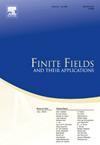Fq-primitive points on varieties over finite fields
IF 1.2
3区 数学
Q1 MATHEMATICS
引用次数: 0
Abstract
Let r be a positive divisor of and a rational function of degree sum d over with some restrictions, where the degree sum of a rational function is the sum of the degrees of and . In this article, we discuss the existence of triples over , where are primitive and is an r-primitive element of . In particular, this implies the existence of -primitive points on the surfaces of the form . As an example, we apply our results on the unit sphere over .
有限域上变异体上的fq -原始点
设r是q−1的正因子,f(x,y)是一个有理函数的阶和d / Fq,有一定的限制条件,其中有理函数f(x,y)=f1(x,y)/f2(x,y)的阶和等于f1(x,y)和f2(x,y)的阶和。本文讨论了Fq上的三元组(α,β,f(α,β))的存在性,其中α,β是原元,f(α,β)是Fq的r-原元。特别地,这意味着在形式为zr=f(x,y)的曲面上存在fq个原始点。作为一个例子,我们将我们的结果应用于Fq上的单位球。
本文章由计算机程序翻译,如有差异,请以英文原文为准。
求助全文
约1分钟内获得全文
求助全文
来源期刊
CiteScore
2.00
自引率
20.00%
发文量
133
审稿时长
6-12 weeks
期刊介绍:
Finite Fields and Their Applications is a peer-reviewed technical journal publishing papers in finite field theory as well as in applications of finite fields. As a result of applications in a wide variety of areas, finite fields are increasingly important in several areas of mathematics, including linear and abstract algebra, number theory and algebraic geometry, as well as in computer science, statistics, information theory, and engineering.
For cohesion, and because so many applications rely on various theoretical properties of finite fields, it is essential that there be a core of high-quality papers on theoretical aspects. In addition, since much of the vitality of the area comes from computational problems, the journal publishes papers on computational aspects of finite fields as well as on algorithms and complexity of finite field-related methods.
The journal also publishes papers in various applications including, but not limited to, algebraic coding theory, cryptology, combinatorial design theory, pseudorandom number generation, and linear recurring sequences. There are other areas of application to be included, but the important point is that finite fields play a nontrivial role in the theory, application, or algorithm.

 求助内容:
求助内容: 应助结果提醒方式:
应助结果提醒方式:


